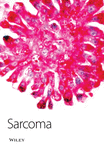Molecular Approaches to Sarcoma Therapy
Abstract
Soft tissue sarcomas comprise a heterogeneous group of aggressive tumors that have a relatively poor prognosis. Although conventional therapeutic regimens can effectively cytoreduce the overall tumor mass, they fail to consistently achieve a curative outcome. Alternative gene-based approaches that counteract the underlying neoplastic process by eliminating the clonal aberrations that potentiate malignant behavior have been proposed. As compared to the accumulation of gene alterations associated with epithelial carcinomas, sarcomas are frequently characterized by the unique presence of a single chromosomal translocation in each histological subtype. Similar to the Philadelphia chromosome associated with CML, these clonal abnormalities result in the fusion of two independent unrelated genes to generate a unique chimeric protein that displays aberrant activity believed to initiate cellular transformation. Secondary gene mutations may provide an additional growth advantage that further contributes to malignant progression. The recent clinical success of the tyrosine kinase inhibitor, STI571, suggests that therapeutic approaches specifically directed against essential survival factors in sarcoma cells may be effective. This review summarizes published approaches targeting a specific molecular mechanism associated with sarcomagenesis. The strategy and significance of published translational studies in six distinct areas are presented. These include: (1) the disruption of chimeric transcription factor activity; (2) inhibition of growth stimulatory post-translational modifications; (3) restoration of tumor suppressor function; (4) interference with angiogenesis; (5) induction of apoptotic pathways; and (6) introduction of toxic gene products. The potential for improving outcomes in sarcoma patients and the conceptual obstacles to be overcome are discussed.




